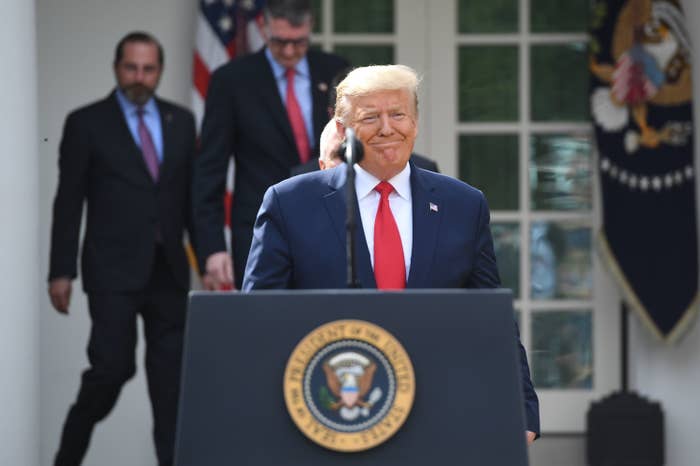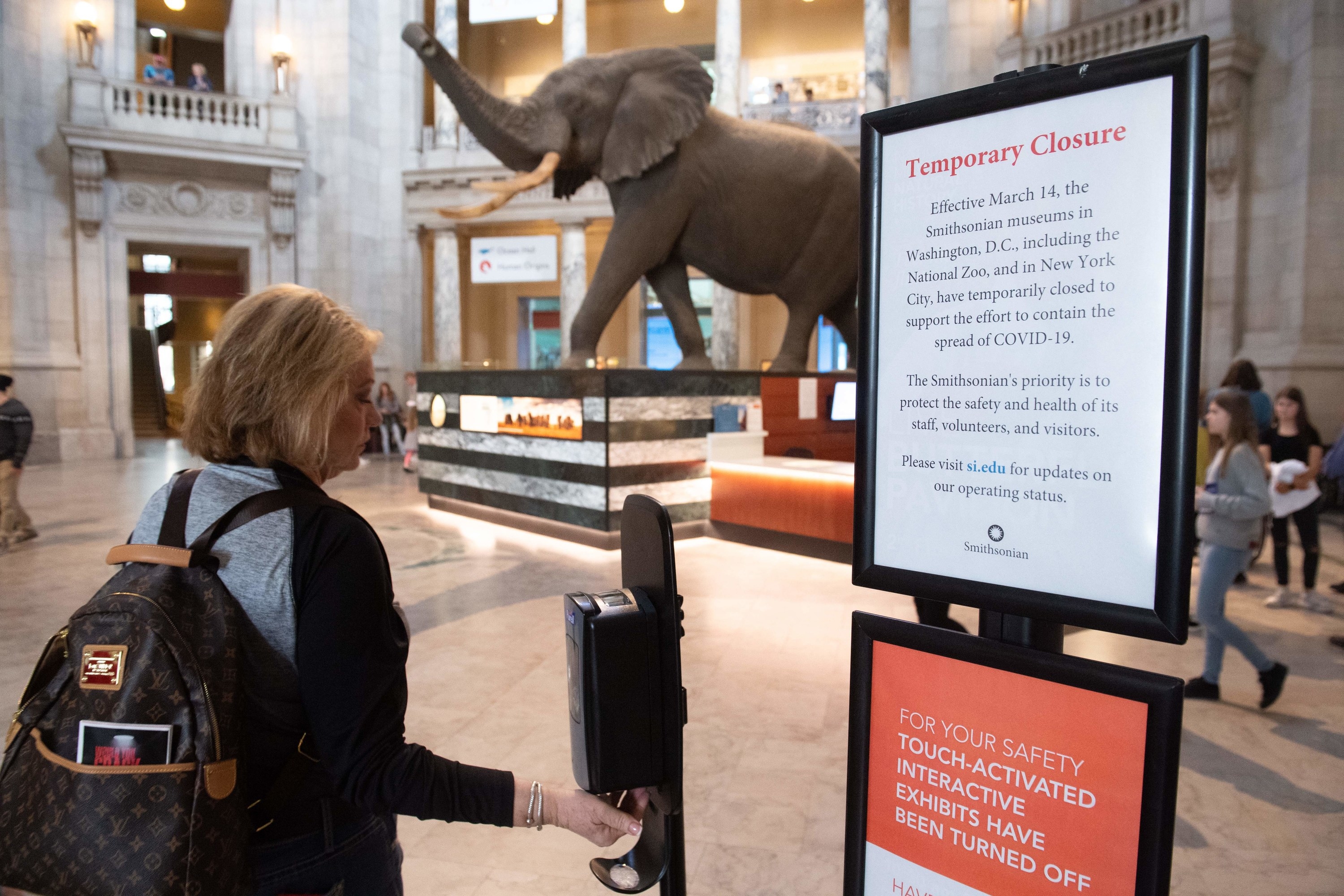
President Trump declared a national state of emergency on Friday over the coronavirus outbreak, unleashing billions of dollars in federal funding and ordering all states to set up emergency operations centers to combat the pandemic.
"To unleash the full power of the federal government, I'm officially declaring a national emergency," Trump told reporters in the White House Rose Garden. "Two very big words."
A number of cities and states have already declared states of emergency, allowing them to access federal aid to address the health crisis, but Trump said the national emergency would unleash a further $50 billion nationally.
The president also ordered hospitals to activate emergency preparedness plans.
"We'll remove or eliminate every obstacle necessary to deliver our people the care that they need and that they're entitled to," he said. "No resource will be spared. Nothing whatsoever."
Trump said Google is setting up an online quiz that people can take to determine whether they need to be tested for the coronavirus. Those who need the test will then be directed to a drive-thru testing area; the CEOs of Walmart, Target, CVS, and Walgreens said they will open their parking lots across the country for testing.
But Google said Friday evening that Trump was incorrect, according to the Verge. The website is being developed not by Google, but another division of its parent company Alphabet, and it will only direct people to testing sites in the Bay Area, at least initially.
Additionally on Friday, Trump announced a public-private partnership to increase testing for COVID-19, saying that the FDA had approved a new test within hours after receiving an application to do so.
"We therefore expect up to half a million additional tests will be available early next week," he said. "We'll be announcing locations probably on Sunday night."
The administration is also directing nursing homes to temporarily restrict visitors and nonessential personnel with a few exceptions, such as end-of-life situations, said Seema Verma, administrator for the Centers for Medicare and Medicaid Services, at the press conference. “We fully appreciate that this measure represents a severe trial for residents of nursing homes and those who love them. But we are doing what we must to protect our vulnerable elderly,” said Verma.
Elderly people are at a much higher risk of dying from a COVID-19 infection. Studies show the mortality rate for people aged 80 and older could be over 20%, while the mortality rates for people under the age of 50 are significantly below 1%.
The president also said he had signed executive orders to waive interest on student loans held by federal government agencies until further notice.
"That's a big thing for a lot of students that are left in the middle right now," he said.
There’s a lot we still don’t know about the coronavirus outbreak. Our newsletter Outbreak Today will do its best to put everything we do know in one place — you can sign up here. Do you have questions you want answered? You can always get in touch. And if you're someone who is seeing the impact of this firsthand, we’d also love to hear from you (you can reach out to us via one of our tip line channels).
Trump also said the United Kingdom may be added to the list of countries that are banned from air travel to the United States. The UK was initially excluded from the ban of 26 European countries that make up the Schengen Area. When asked why the UK was excluded when it has more cases of confirmed coronavirus than many of the banned European countries, Trump said, “We may have to include them in the list.”
Trump also said that due to plummeting oil prices, he has directed Energy Secretary Dan Brouillette to purchase large quantities of oil for strategic reserves.
Trump was also asked Friday about his contact with Brazilian President Jair Bolsonaro last weekend at his Mar-a-Lago property. A Bolsonaro staffer who was there tested positive for COVID-19, while the Brazilian president himself has said he tested negative.
"We have no symptoms whatsoever," Trump said of himself and his staffers. He later added, "As you know, he tested negative, meaning nothing wrong this morning, and we got that word too — because we did have dinner with him, uh, we were sitting next to each other for a long period of time."
Asked why he wasn't self-isolating, as other politicians who have interacted with those who have tested positive for the disease have done, Trump reiterated: "I don't have any of the symptoms. We have a White House doctor — I should say many White House doctors. I asked them that same question, and they said, 'you don't have any symptoms whatsoever.'"
The national emergency comes amid widespread criticism over his administration's slow response to the outbreak so far as well as the federal government's missteps in testing for the disease.
States such as Washington and California had been pleading with Trump to declare a state of emergency so they can mobilize their Medicaid systems to fight the coronavirus outbreak.
As first reported by Talking Points Memo, states have wanted to loosen Medicaid rules to both provide more care and offer more options for people to receive health services. Essentially, they want to make the system more flexible to prevent it from being overwhelmed.
However, they’ve been hamstrung by the Trump administration because making these changes requires specific waivers — known as 1135 waivers — that can only be used when the president has declared an emergency. But for weeks now, Trump has refused such a declaration and downplayed the danger posed by the COVID-19 pandemic.

The first known case of COVID-19, the disease caused by the novel coronavirus, in the US was reported on Jan. 21 in Washington state. More than 1,700 cases have been reported in nearly every state in the country since, and 41 people have died so far.
Experts say it's highly likely that there are many more COVID-19 cases than the official number. After the CDC initially bungled the rollout of test kits, officials say the government is still "failing" at providing adequate testing for the coronavirus.
As the outbreak escalates across the country, organizers have postponed major sporting and entertainment events, schools have moved to online classes, and shoppers have gone on panicked sprees, buying supplies and emptying shelves at supermarkets and pharmacies.
In an effort to flatten the curve of the epidemic, people have been advised to practice social distancing, though many are struggling with mixed messages from officials — and especially from the president — on how seriously they should take this outbreak.
Since the first COVID-19 case was reported, Trump has attempted to downplay the severity of the outbreak. He initially claimed he "shut it down coming in from China," where the first case was reported, and asserted that the virus was "under control" in the US.
Trump continued to praise US health officials as the number of cases rose across the country. He claimed in March that "anybody that wants a test can get a test," contradicting health officials and experts who've criticized the government's inadequacy at testing for the virus.
Q: The president has said that anybody who wants a test can get a test. Is that consistent with what you heard in there? Lankford: No, that’s not consistent right now. That’s obviously the goal.. but that’s not accurate right now. https://t.co/IPWNF5tFyR
In a Wednesday address, President Trump left people reeling and confused as he announced measures to curb the spread of the virus. He declared a ban on travel from Europe — which officials later had to clarify did not apply to US citizens or permanent residents — claimed the ban applied to cargo, which he later walked back, and said insurance companies would waive copayments for COVID-19 treatment. (Companies later said they were only waiving copayments for testing, not treatment.)

